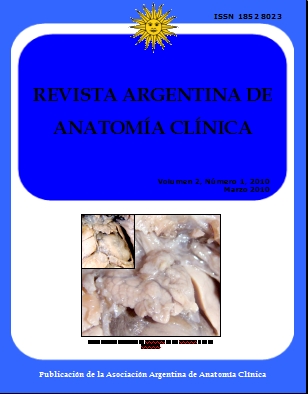CAMBIOS MORFOLÓGICOS DEL TIMO EN LA ETAPA FETAL Y SU IMPORTANCIA CLÍNICA. MORPHOLOGICAL CHANGES OF THE THYMUS IN THE FETAL STAGE AND ITS CLINICAL SIGNIFICANCE
DOI:
https://doi.org/10.31051/1852.8023.v2.n1.13857Palabras clave:
embriología, pleura, pericardio, cápsula tímica, embryology, pericardium, thymic capsule, fetal morphology, morfología fetalResumen
El timo se origina de la tercera bolsa faríngea, durante la 5ª semana de gestación, cuando migra junto con las paratiroides inferiores, hasta alcanzar su posición definitiva. El crecimiento y desarrollo del timo continúa después del nacimiento hasta la pubertad, ocupando una posición cervico-torácica. En este trabajo se miden y correlacionan los cambios en forma y tamaño del timo fetal, y se correlaciona su aspecto macroscópico con variaciones clínicas. Se estudiaron 80 fetos entre 14 y 21 semanas de gestación. El timo fue disecado conservando sus relaciones anatómicas más importantes. Observamos que la longitud de la glándula crece abruptamente entre la semana 17 y 18. Luego de la semana 18 el crecimiento en longitud de la glándula se mantiene de manera progresiva. El ancho del timo tiene un crecimiento notable entre la semana 15 y 16. El crecimiento total de la glándula, de la semana 14 a la 21, fue: 74,96% en su longitud, y 119,5% en el ancho. Analizando los datos obtenidos surge que el aumento de longitud y ancho del timo se acompaña del desarrollo anatómico del aparato cardiovascular y respiratorio respectivamente, en las mismas etapas, pudiendo confirmar que esto se deba a la relación existente entre la cápsula tímica, pleura y pericardio, que acompañan su crecimiento por arrastre. Destacamos el estudio de las dimensiones tímicas en el control prenatal, actuando como parámetro predictivo para la detección de patologías relacionadas con el sistema inmune y con patologías que afectan a otros órganos o sistemas relacionados.
During the fifth week of gestation, appears the third branchial pouch that will migrate originating the thymus and the superior parathyroid glands. Thymus growth and development will continue after birth until puberty, and always occupying a cervico-thoracic position. In this study we show shape and size variations of fetal thymus, and the correlation between its macroscopic aspect and clinical variations. We studied 80 fetuses between 14 and 21 weeks of gestation. The thymus was dissected respecting the relationship with the main anatomical structures. We demonstrated that the gland length suddenly grows between the week 17th and 18th. After that length growth continues progressively. Thymus breadth evidently grows between the weeks 15th and 16th. General growth of the gland, between the weeks 14th and 21st was 74.96% in length and 119.5% in breadth. Considering these data it appears as evident that the increasing in length and breadth of the thymus is related to the anatomical development of the cardio-vascular and respiratory systems respectively, in the same stages, confirming the relationship between the thymus capsule, pleura and pericardium, that determines the morphology of this growth by “traction”. We emphasize the study of thymus measures in pregnant controls as a predictive parameter for the detection of pathologies associated to the immunological system and other related organs or systems.
Referencias
Aspinall R, Mitchell W. 2008. Reversal of age-associated thymic atrophy: Treatments, delivery, and side effects. Exp Gerontol, 43: 700-705.
Carlson B. 2005. Embriología humana y biología del desarrollo. 3º Edición, España: Editorial Elseiver, pág: 341-343.
Cunningham C, Kimpton W, Holder J, Cahilly R. 2001. Thymic export in aged sheep: a continuous role for the thymus throughout pre- and postnatal life. Eur J Immunol, 31: 802-811.
De Felipe C, Latini G, Del Vecchio A, Toti P, Bagnoli F, Petraglia F. 2003. Small thymus at birth and neonatal outcome in very low birth weight infants. Eur J Pediatr, 162: 204–206.
Douek D. 1998. Cambios en la función del timo con la edad y durante el tratamiento de la infección por el VIH. Nature, 396: 690-695.
El-Haieg DO, Zidan AA, El-Nemr MM. 2008. The relationship between sonographic fetal thymus size and the components of the systemic fetal inflammatory response syndrome in women with preterm prelabour rupture of membranes. BJOG, 115: 836-841.
Hakim MT, Gress RE. 2007. Thymic involution: implications for self-tolerance. Methods Mol Biol, 380: 377-390.
Hale JS, Boursalian TE, Turk GL, Fink PJ. 2006. Thymic output in aged mice. Proc Natl Acad Sci EEUU, 103: 8447-8452.
Hib J. 1999. Embriología Médica. 7º Edición, Santiago de Chile: Editorial Interamericana Mc Graw Hill, pág: 144-146.
Hince M, Sakkal S, Vlahos K, Dudakov J, Boyd R, Chidgey A. 2008. The role of sex steroids and gonadectomy in the control of thymic involution. Cell Immunol, 252: 122-138.
Prives M, Lisenkov M, Bushkovich V. 1985. Anatomía Humana. Tomo III. 5º Edición. Moscú: Editorial Mir, pág: 157-159.
Sadler TW. 2003. Langman's Medical Embryology. 9th Edition. Twin Bridges (Montana): Editorial Lippincott Williams & Wilkins, pag: 373 – 374.
Steinmann GG. 1986. Changes in the human thymus during aging. Curr Top Pathol. 75: 43-88.
Tosi P, Kraft R, Luzi P, Cintorino M, Frankhauser G, Hess MW, Cottier H. 1982. Involution patterns of the human thymus. I Size of the cortical area as a function of age. Clin Exp Immunol, 47: 497-504.
Yinon Y, Zalel Y, Weisz B, Mazaki-Tovi S, Sivan E, Schiff E, Achiron R. 2007. Fetal thymus size as a predictor of chorioamnionitis in women with preterm premature rupture of membranes. Ultrasound Obstet Gynecol, 9: 639-643.
Descargas
Publicado
Número
Sección
Licencia
Los autores/as conservarán sus derechos de autor y garantizarán a la revista el derecho de primera publicación de su obra, el cuál estará simultáneamente sujeto a la Licencia de reconocimiento de Creative Commons que permite a terceros compartir la obra siempre que se indique su autor y su primera publicación en esta revista. Su utilización estará restringida a fines no comerciales.
Una vez aceptado el manuscrito para publicación, los autores deberán firmar la cesión de los derechos de impresión a la Asociación Argentina de Anatomía Clínica, a fin de poder editar, publicar y dar la mayor difusión al texto de la contribución.



